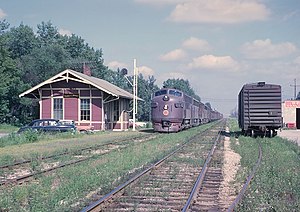Chicago Great Western Railway
 |
|

A CGW freight train passing Elmhurst, Illinois in 1962
|
|
| Reporting mark | CGW |
|---|---|
| Locale | Minneapolis, Minnesota, Oelwein, Iowa, Chicago, Illinois, Kansas City, Kansas and Omaha, Nebraska |
| Dates of operation | 1885–1968 |
| Successor | Chicago and North Western |
| Track gauge | 4 ft 8 1⁄2 in (1,435 mm) |
| Headquarters | Oelwein, Iowa / Chicago, Illinois |
The Chicago Great Western Railway (reporting mark CGW) was a Class I railroad that linked Chicago, Minneapolis, Omaha, and Kansas City. It was founded by Alpheus Beede Stickney in 1885 as a regional line between St. Paul and the Iowa state line called the Minnesota and Northwestern Railroad. Through mergers and new construction, the railroad, named Chicago Great Western after 1892, quickly became a multi-state carrier. One of the last Class I railroads to be built, it competed against several other more well-established railroads in the same territory, and developed a corporate culture of innovation and efficiency to survive.
Nicknamed the Corn Belt Route because of its operating area in the midwestern United States, the railroad was sometimes called the Lucky Strike Road, due to the similarity in design between the herald of the CGW and the logo used for Lucky Strike cigarettes.
In 1968 it merged with the Chicago and North Western Railway (CNW), which abandoned most of the CGW's trackage.
In 1835, the Chicago, St. Charles & Mississippi Airline railroad was chartered with the intent of building a railroad west out of Chicago. The railroad never began construction, and its rights to build were transferred in 1854 to a new company, the Minnesota & North Western (M&NW), which eventually began construction in 1884 of a line south from St. Paul, Minnesota to Dubuque, Iowa. In 1887, the Chicago, St. Paul & Kansas City Railroad acquired the M&NW, and by the end of the decade, under the leadership of St. Paul businessman A. B. Stickney, it had established routes west to Omaha, Nebraska, south to St. Joseph, Missouri, and east to Chicago, Illinois, via the Winston Tunnel near Dubuque. In 1892, the railroad was reorganized as the Chicago Great Western.
In 1907, the panic of 1907 caused Stickney to lose control of the railroad, and ownership passed to financier J. P. Morgan. In 1910, the CGW introduced four McKeen Motor Car Company self-propelled railcars, its first rolling stock powered by internal combustion engines. In the same year, the railroad also purchased ten large 2-6-6-2s from the Baldwin Locomotive Works. Two years later, the railroad acquired an experimental battery powered motorcar from the Federal Storage Battery Car Company. In 1916, the railroad began standardizing on 2-8-2 steam locomotives, which served through the 1920. During the 1920s, as ownership changed again to the Bremo Corporation, a group of investors led by Patrick Joyce, an executive at the Standard Steel Car Company, the railroad expanded its use of self-propelled vehicles. At the end of the decade, 36 2-10-4 steam locomotives were purchased from Baldwin and the Lima Locomotive Works.
...
Wikipedia
